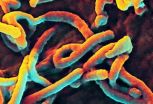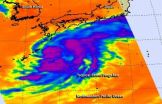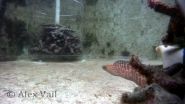(Press-News.org) One shot of an experimental vaccine made from two Ebola virus gene segments incorporated into a chimpanzee cold virus vector (called chimp adenovirus type 3 or ChAd3) protected all four macaque monkeys exposed to high levels of Ebola virus 5 weeks after inoculation, report National Institutes of Health (NIH) scientists and their collaborators. The ability of the ChAd3 Ebola virus vaccine to elicit rapid protection in monkeys is notable as the world health community battles an ongoing Ebola virus disease outbreak in West Africa. While the protective effects of the single shot waned over time, two out of four inoculated animals were protected when challenged with Ebola virus 10 months after vaccination.
The research team, headed by Nancy J. Sullivan, Ph.D., of the National Institute of Allergy and Infectious Diseases Vaccine Research Center, also demonstrated increased levels of durable protection using an additional vaccine. They inoculated four macaques first with the ChAd3 Ebola vaccine, then 8 weeks later with a booster vaccine containing Ebola virus gene segments incorporated into a different vector (a poxvirus). Ten months after the initial inoculation, four out of four animals that received both shots were fully protected from infection with high doses of Ebola virus, demonstrating that the prime-boost regimen resulted in durable protection.
INFORMATION:
The research team included scientists from Okairos, a Swiss-Italian biotechnology company now part of GlaxoSmithKline, and the U.S. Army Medical Research Institute of Infectious Diseases. The experimental ChAd3 Ebola vaccine used in these non-human primate studies is the same one currently being tested in an early-stage human clinical trial at the NIH in Bethesda, Maryland.
Article
DA Stanley et al. Chimpanzee adenovirus vaccine generates acute and durable protective immunity against ebolavirus challenge. Nature Medicine DOI:10.1038/nm.3702 (2014).
NIAID Director Anthony S. Fauci, M.D., is available to comment on this research. Nancy J. Sullivan, Ph.D, Chief, Biodefense Research Section, Vaccine Research Center, NIAID is also available to comment.
Contact
To schedule interviews, please contact NIAID Office of Communications, (301) 402-1663, niaidnews@niaid.nih.gov.
NIAID conducts and supports research—at NIH, throughout the United States, and worldwide—to study the causes of infectious and immune-mediated diseases, and to develop better means of preventing, diagnosing and treating these illnesses. News releases, fact sheets and other NIAID-related materials are available on the NIAID Web site at http://www.niaid.nih.gov.
About the National Institutes of Health (NIH)
NIH, the nation's medical research agency, includes 27 Institutes and Centers and is a component of the U.S. Department of Health and Human Services. NIH is the primary federal agency conducting and supporting basic, clinical, and translational medical research, and is investigating the causes, treatments, and cures for both common and rare diseases. For more information about NIH and its programs, visit http://www.nih.gov.
NIH...Turning Discovery Into Health®
Rapid and durable protection against ebola virus with new vaccine regimens
NIH scientists and collaborators report positive results in monkeys
2014-09-08
ELSE PRESS RELEASES FROM THIS DATE:
Teens living with 2 college-educated parents less likely to use alcohol and marijuana
2014-09-08
ARLINGTON, Texas -- A high school senior who lives with two college-educated parents is significantly less likely to drink alcohol or smoke marijuana than a teenager who lives with one parent, a new University of Texas at Arlington study has found.
For example, teens living with their mother only are 54 percent more likely to use alcohol, and 58 percent more likely to smoke if they live only with their father.
Eusebius Small, an assistant professor in the UT Arlington School of Social Work, analyzed data on 14,268 teenagers to determine the impact of family structure ...
Ohio University paleontologists discover new species of titanosaurian dinosaur in Tanzania
2014-09-08
ATHENS, Ohio (Sept. 8, 2014)—Ohio University paleontologists have identified a new species of titanosaurian, a member of the large-bodied sauropods that thrived during the final period of the dinosaur age, in Tanzania. Although many fossils of titanosaurians have been discovered around the globe, especially in South America, few have been recovered from the continent of Africa.
The new species, named Rukwatitan bisepultus, was first spotted by scientists embedded in a cliff wall in the Rukwa Rift Basin of southwestern Tanzania. Using the help of professional excavators ...
In one of nature's innovations, a single cell smashes and rebuilds its own genome
2014-09-08
Life can be so intricate and novel that even a single cell can pack a few surprises, according to a study led by Princeton University researchers.
The pond-dwelling, single-celled organism Oxytricha trifallax has the remarkable ability to break its own DNA into nearly a quarter-million pieces and rapidly reassemble those pieces when it's time to mate, the researchers report in the journal Cell. The organism internally stores its genome as thousands of scrambled, encrypted gene pieces. Upon mating with another of its kind, the organism rummages through these jumbled genes ...
Gobbling up poison: A method for killing colon cancer
2014-09-08
(PHILADELPHIA) – These days, cancer researchers aim to design targeted and specific therapy – those that kill cancer but spare the surrounding tissue. Immunotoxins, which use cancer-targeted antibodies linked to deadly toxins such as ricin, are one such therapy. However, few have succeeded to date in part because cancer cells share many molecules with normal cells, and because it can be challenging to unlock the deadly chemical only after the antibody has homed to the diseased tissue.
Now researchers at Thomas Jefferson University have discovered the unique biological ...
Soft robot squirms over fire, ice, and withstands crushing force
2014-09-08
ITHACA, N.Y. – Engineers have created a shape-changing "soft" robot that can tread over a variety of adverse environmental conditions including snow, puddles of water, flames, and the crushing force of being run over by an automobile.
Videos: https://cornell.box.com/softrobot
The engineers from Cornell and Harvard Universities will detail the robot in an upcoming edition of the journal Soft Robotics. An early online version of the study can be found at: http://online.liebertpub.com/doi/full/10.1089/soro.2014.0008
The pneumatically powered, fully untethered robot was ...
NASA sees large Tropical Storm Fengshen skirting eastern Japan's coastline
2014-09-08
Tropical Storm Fengshen is a large storm and infrared imagery from NASA's Aqua satellite shows that it's about as long as the big island of Japan.
NASA's Aqua satellite passed over Tropical Storm Fengshen on September 7 and the Atmospheric Infrared Sounder instrument known as AIRS gathered temperature data about the storm's cloud tops and surrounding sea surface temperatures. The infrared data showed strong thunderstorms surrounded the center of circulation and also appeared in large bands south and northeast of the storm's center. Another large and fragmented band on ...
Yale study shows how conversion of forests to cropland affected climate
2014-09-08
The conversion of forests into cropland worldwide has triggered an atmospheric change that, while seldom considered in climate models, has had a net cooling effect on global temperatures, according to a new Yale study.
Writing in the journal Nature Climate Change, Professor Nadine Unger of the Yale School of Forestry & Environmental Studies (F&ES) reports that large-scale forest losses during the last 150 years have reduced global emissions of biogenic volatile organic compounds (BVOCs), which control the atmospheric distribution of many short-lived climate pollutants, ...
Brain damage caused by severe sleep apnea is reversible
2014-09-08
DARIEN, IL – A neuroimaging study is the first to show that white matter damage caused by severe obstructive sleep apnea can be reversed by continuous positive airway pressure therapy. The results underscore the importance of the "Stop the Snore" campaign of the National Healthy Sleep Awareness Project, a collaboration between the Centers for Disease Control and Prevention, American Academy of Sleep Medicine, Sleep Research Society and other partners.
Results show that participants with severe, untreated sleep apnea had a significant reduction in white matter fiber integrity ...
A bird-pollinated flower with a rather ingenious twist
2014-09-08
VIDEO:
When a bird forages on nectar, the flower twists as the spur complies with the shape of the
bird's bill. In consequence, pollen is placed in an unusual location on...
Click here for more information.
When researchers studying several bird-pollinated species of Impatiens flowers in the mountains of western Cameroon noticed one with an odd, upwardly curving nectar spur, they couldn't imagine how any sunbird could ever sip from it. After recording visitors to the flower continuously ...
Coral trout pick their collaborators carefully
2014-09-08
VIDEO:
Coral trout are choosey about moray collaborators.
Click here for more information.
Coral trout not only work with moray eels to improve their chances of a meal, but they can also be choosy when it comes to picking the best moray partner. The findings reported in the Cell Press journal Current Biology on September 8 show that such sophisticated collaborative abilities are not limited to apes and humans.
The fish's behavior is remarkable in other ways too, the researchers ...
LAST 30 PRESS RELEASES:
Numbers in our sights affect how we perceive space
SIMJ announces global collaborative book project in commemoration of its 75th anniversary
Air pollution exposure and birth weight
Obstructive sleep apnea risk and mental health conditions among older adults
How talking slows eye movements behind the wheel
The Ceramic Society of Japan’s Oxoate Ceramics Research Association launches new international book project
Heart-brain connection: international study reveals the role of the vagus nerve in keeping the heart young
Researchers identify Rb1 as a predictive biomarker for a new therapeutic strategy in some breast cancers
Survey reveals ethical gaps slowing AI adoption in pediatric surgery
Stimulant ADHD medications work differently than thought
AI overestimates how smart people are, according to HSE economists
HSE researchers create genome-wide map of quadruplexes
Scientists boost cell "powerhouses" to burn more calories
Automatic label checking: The missing step in making reliable medical AI
Low daily alcohol intake linked to 50% heightened mouth cancer risk in India
American Meteorological Society announces Rick Spinrad as 2026 President-Elect
Biomass-based carbon capture spotlighted in newly released global climate webinar recording
Illuminating invisible nano pollutants: advanced bioimaging tracks the full journey of emerging nanoscale contaminants in living systems
How does age affect recovery from spinal cord injury?
Novel AI tool offers prognosis for patients with head and neck cancer
Fathers’ microplastic exposure tied to their children’s metabolic problems
Research validates laboratory model for studying high-grade serous ovarian cancer
SIR 2026 delivers transformative breakthroughs in minimally invasive medicine to improve patient care
Stem Cell Reports most downloaded papers of 2025 highlight the breadth and impact of stem cell research
Oxford-led study estimates NHS spends around 3% of its primary and secondary care budget on the health impacts of heat and cold in England
A researcher’s long quest leads to a smart composite breakthrough
Urban wild bees act as “microbial sensors” of city health.
New study finds where you live affects recovery after a hip fracture
Forecasting the impact of fully automated vehicle adoption on US road traffic injuries
Alcohol-related hospitalizations from 2016 to 2022
[Press-News.org] Rapid and durable protection against ebola virus with new vaccine regimensNIH scientists and collaborators report positive results in monkeys





